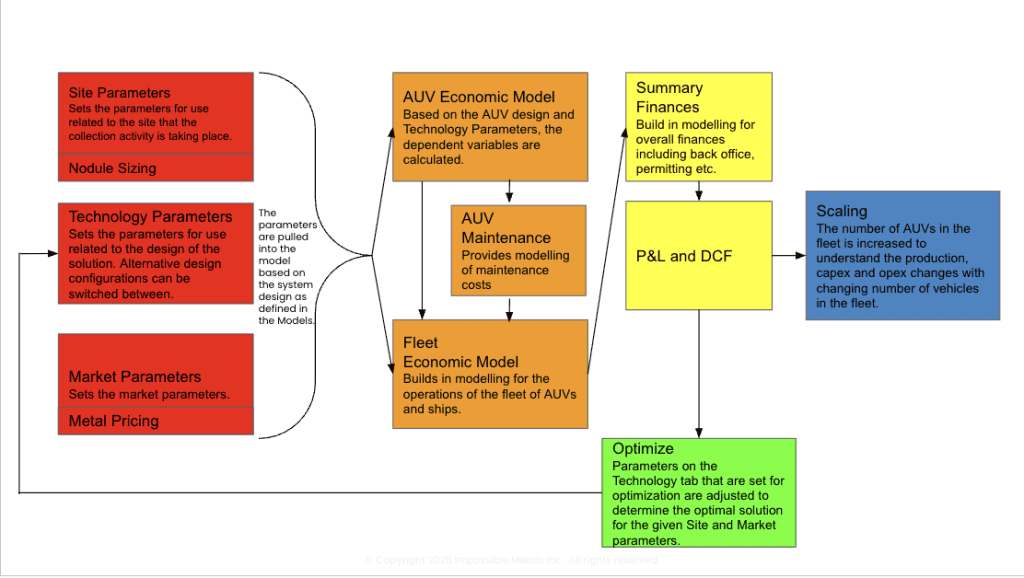
The Techno-Economic Analysis (TEA) describes the design of the Eureka collection system, marking a step forward in refining our understanding of the economic and operational parameters for the selective collection of polymetallic nodules.
There are three reasons why this matters.
- Environmental Stewardship: At Impossible Metals, we prioritize harvesting critical minerals with low levels of impact to the seabed. The latest model further refines our design approach to ensure that we are not just economically viable but also true to our mission of preserving and protecting the marine environment.
- Scalability: By outlining potential fleet sizes and production rates, we aim to provide investors and stakeholders with a clear vision of expanding our operations, while offering flexible entry points for different market conditions.
- Transparency: We believe in openly sharing our methods and assumptions. The webinar and slideshow contain detailed breakdowns of costs, technologies, and economic indicators, allowing for informed dialogue with partners, regulators, and the broader community.
What’s New in the Latest Version (v6)
- Revised Processing Location Assumption
We updated our base assumption to use Japan as the primary processing location, increasing the travel distance compared to North America, impacting logistics and associated costs. This change was made to reflect a wider range of possible processing locations. - Nodule Sizing and Collection
In alignment with our goal of preserving marine habitats, we now leave 30% of nodules (by mass) undisturbed and over 60% of all nodules undisturbed by collecting larger nodules. Ultimately, the percentage of nodules left behind will be informed by future environmental studies. - Ship Type and Maintenance Costs
We transitioned from container vessels to bulk carriers, significantly increasing capacity. We also removed duplicate maintenance cost assumptions present in earlier versions, leading to more accurate operating expense (OPEX) figures. - Fleet Scalability
Our updated model examines different fleet configurations, such as Eureka III (2.25 million tonnes per year) and Eureka IV (6.7 million tonnes per year). This shows how capital expenditures, operating expenditures, and production volumes scale up with larger fleets. - Competitive Cost Analysis
The slideshow compares Impossible Metals’ selective harvesting approach to terrestrial and deep-sea mining techniques. Our findings continue to show encouraging figures, with a strong Net Present Value (NPV) and competitive all-in sustaining costs (AISC). - Representative Project Economics
The slides describe a 30-year project scenario using v6 model assumptions. Highlights included projected revenues, capital requirements, royalty structures, and overall cost of capital. These details help demonstrate the commercial viability of our selective harvesting model.
Project 1 Profit & Loss
Project 1 P&L presents a high-level concept profit and loss model for a representative project, offering a clear view of economic performance under current assumptions. The scenario outlines projected revenues, direct and operating costs, and profitability margins across the life of the project, framed by our v6 modeling parameters. While structured in a typical P&L format, it’s tailored to the unique aspects of selective nodule harvesting and processing, helping to demonstrate the financial viability and key value drivers of our approach.
Access the spreadsheet here.
Alternative Comparison
The Alternative Comparison provides a side-by-side economic analysis of Impossible Metals’ selective harvesting model versus published terrestrial and conventional deep-sea mining alternatives. The review benchmarks key financial metrics, such as capital expenditures, operating costs, all-in sustaining costs (AISC), and projected returns, to position our selective nodule harvesting approach within the broader mining landscape. By grounding this comparison in peer-reviewed and industry-standard data, the analysis highlights how our method stacks up on cost efficiency and commercial viability.
Access the spreadsheet here.
Techno-Economic Analysis

Model Introduction (Tabs)
Access the TEA here.
Please also see section I of the FAQ.
Next Steps for This Model
Further Validation: We are actively refining and validating the V6 model parameters through ongoing engineering efforts, analysis of test data, and incorporation of feedback from key stakeholders. This process ensures that our models remain robust, accurate, and aligned with real-world performance expectations.
Continuous Improvement: As we continue to gather new data from testing and validation activities, we will release further updates. These improvements will help us refine our fleet designs and integrate practical insights into future versions of the model, ensuring continual advancement and relevance.
Learn More
View the presentation.
Watch the webinar.